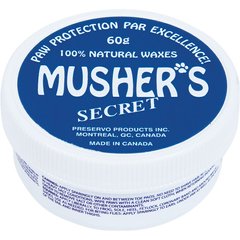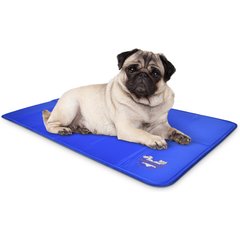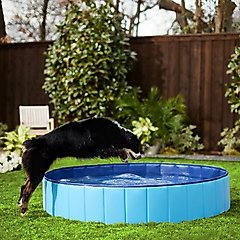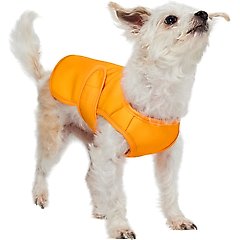How Hot Is Too Hot for Dogs?
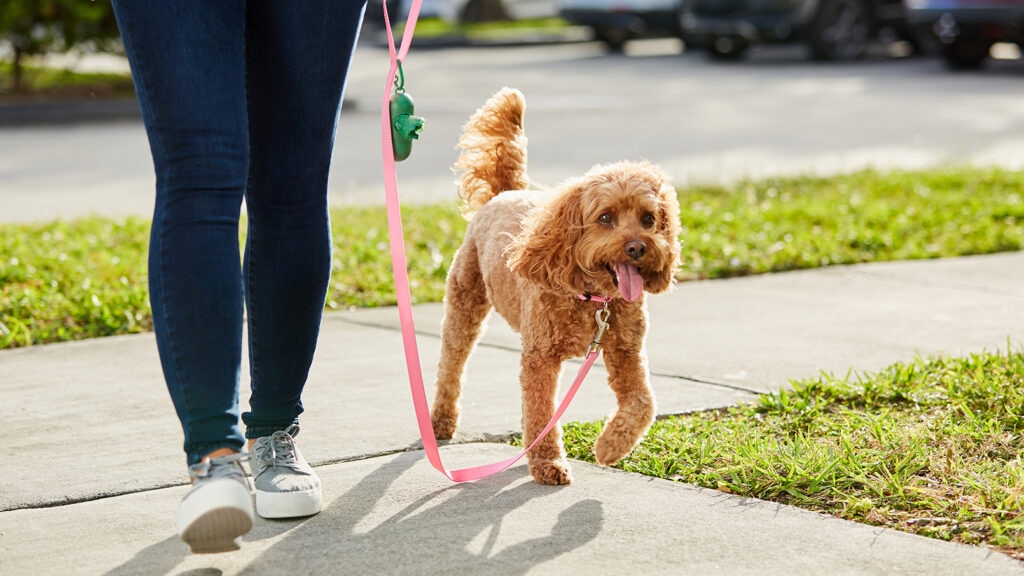
Photo by Chewy
When the weather starts to heat up, it’s only natural to want to get outside and enjoy it with your pup. But dogs don’t handle heat the same way humans do, and they can overheat pretty quickly if you’re not paying attention. So how hot is too hot for dogs, exactly?
There’s no one-size-fits-all answer, but there are some temperature thresholds and signs to watch for. Here’s what you should know to help keep your dog safe all summer long.
Key Takeaways
- Dogs are most comfortable at 65-75°F; limit outdoor time when it's over 80°F.
- Walk dogs during cooler hours and always provide shade and fresh water.
- Never leave dogs in parked cars, as temperatures can rise dangerously in minutes.
How Hot Is Too Hot for a Dog?

Photo by Chewy
Dogs are generally comfortable resting between 45–80 F, but their ideal activity range is around 65–75 F, according to Michael Hyder, DVM, medical director at VEG ER for Pets in Palo Alto, California.
Above that, you’ll want to take extra care, especially when it’s humid. Humidity makes it harder for dogs to cool down through panting, increasing the chance of heat stress and dehydration.
Because of this, you’ll want to pay attention to the heat index, or what some weather apps call the “feels like” temperature. The heat index takes both temperature and humidity into account. If it’s above 80 F, keep your dog inside or in shaded areas with access to cool water.
Here’s a quick temperature guide to help you gauge your dog’s safety:
When Is It Too Hot To Walk Your Dog?
As a general rule, avoid walking your dog if the temperature is over 80 F. But ultimately, it depends on the dog.
Dr. Hyder says that even upper 70s can be dangerous for heat-sensitive breeds. That includes dogs with short snouts, like French Bulldogs, and those with long, thick coats, like Huskies and German Shepherds.
Which Dogs Are Most Sensitive to Heat?
While all dogs can overheat, some are more vulnerable than others. Keep a closer eye on your pup if they:
- Are a flat-faced (brachycephalic) breed: Certain breeds like Bulldogs, Pugs, and Boxers have shorter airways, making it harder for them to breathe and regulate body temperature, according to Brigita Ziogaite, DVM, veterinarian at LeadER Animal Specialty Hospital in Boca Raton and Cooper City, Florida.
- Are overweight: Excess body fat traps heat, making overweight dogs more prone to overheating, even with little activity.
- Are a senior or a puppy: Older dogs and very young pups are less efficient at regulating their body temperature than healthy, adult dogs.
- Have a thick or dark coat: Heavy or dark-colored fur can trap heat or absorb sunlight more quickly.
- Have a chronic health condition: Conditions like heart disease or respiratory issues can increase the risk of overheating.
- Are a large breed: Bigger dogs often generate and retain more body heat than smaller breeds.
- Are very active or high-energy: Working breeds or very active dogs may push themselves too hard without recognizing their limits.
What Happens When Dogs Get Too Hot?
When dogs get too hot, things can go downhill quickly. Overheating can lead to heat exhaustion, dehydration, or even heatstroke, which is a medical emergency.
Dr. Hyder notes that many overheating cases happen on days between 75–85 F. That’s because it feels mild to humans, but dogs can quickly overheat, especially if they’re running or playing.
Keep activity light on warmer days and pay close attention to how your dog acts. Here’s what to look for and what to do if your dog gets too hot:
Heat Exhaustion
Heat exhaustion occurs when your dog’s body temperature reaches 104 F.
At this point, they may still be able to cool themselves down, but it’s important to take quick action so it doesn’t progress to heatstroke, which is more serious.
Signs of heat exhaustion include:
- Excessive panting or drooling
- Bright red gums or tongue
- Weakness or lethargy
- Vomiting or diarrhea
- Disorientation or stumbling
- Rapid heart rate
If you notice any of these signs:
- Get your dog to a cooler place immediately.
- Offer small amounts of room temperature (not cold) water.
- Contact your vet if symptoms don’t quickly improve.
Heatstroke
Heatstroke happens when your dog’s body temperature gets to 105 F or higher. At this point, your dog can’t cool themselves down on their own.
If you see any of these signs in your dog, take them to the emergency vet clinic immediately:
- Excessive panting or difficulty breathing
- Disorientation or confusion
- Vomiting or diarrhea (may be bloody)
- Collapse or loss of coordination
- Red or bruised-looking gums
Dehydration
Dehydration often goes hand in hand with overheating. And it can sneak up quickly in hot weather, especially if your dog isn’t drinking enough water.
If left untreated, it can lead to more serious complications like organ damage.
Some signs of dehydration include:
- Dry or tacky gums
- Thick or sticky saliva
- Lethargy
- Sunken eyes
- Dry nose
- Decreased appetite
- Reduced urination
- Excessive panting
If your dog shows signs of dehydration, encourage them to drink water and contact your vet for guidance. Mild dehydration can be corrected by drinking water, but severe dehydration requires emergency care.
How To Safely Walk Your Dog in the Summer
Hot weather doesn’t mean you have to skip walks altogether, but it does mean taking a few extra steps to keep your dog safe.
You should only walk your dog if the temperature is below 80 F. If it’s over that, outdoor time should be limited to quick potty breaks only.
Here are some quick tips to make summer walks safer:
- Avoid peak sun times. Dr. Ziogaite recommends walking your dog earlier in the morning (before 10 a.m.) or later in the evening (after 5 p.m.) when it’s cooler.
- Test the pavement. Before you take your dog out, put the back of your hand on the pavement for about five seconds. If it feels too hot for you, it’s too hot for your dog’s paws.
- Bring water. Carry fresh water with a collapsible bowl , like this one from Frisco, so your dog can drink during the walk. Don’t forget to bring some for yourself too!
Recommended Product
- Invest in dog booties. You can protect your dog’s paws by putting a pair of dog shoes on them, like these from Ruffwear, or applying a wax product like Musher’s Secret Paw Protection Dog Wax.
Recommended Products
- Stick to grass or dirt paths. Pavement and cement can get dangerously hot and burn your dog’s paws, says Dr. Ziogaite. When possible, stick to grassy areas or trails, which stay cooler than pavement.
- Be mindful of your route. If you can’t avoid pavement, find a walking path with shade or access to cooler areas, like a pond or stream.
- Keep it short and slow. Stick to five to 15 minutes at a time at peak hours, and go at a slow pace. In the evenings, you may be able to walk up to 30 minutes if it’s cooler and your dog tolerates heat well.
- Watch for signs of overheating. Pay close attention to your dog. If they show signs of heat exhaustion or dehydration, get them to a cooler spot immediately.
How To Keep Your Dog Cool
Dogs don’t sweat like humans do. Instead, they use panting to cool off, which isn’t always enough in warm conditions, says Dr. Hyder.
Because of this, your dog might need help staying cool when the temperatures rise. Here are things you can do:
- Provide shade and water when outside.
- Let them relax on a cooling mat , like the Arf Pets Self-Cooling Mat, or damp towels.
Recommended Product
- Give them frozen dog treats, like these Woof Pupsicle Pops.
Recommended Product
- Set up a dog pool, like the Frisco Outdoor Dog Swimming Pool, or a sprinkler, like the PetFit for Life Step-On Sprinkler.
Recommended Products
- Use a cooling vest, like the Frisco Summer UPF 45 Cooling Dog Vest, or a bandana, like the Frisco Summer Cooling Pullover Gaitor, on especially hot days.
Recommended Products
FAQs About How Hot Is Too Hot for Dogs
Q: How hot is too hot for dogs in a car?
A: It’s never safe to leave a dog alone in a car on a warm day, even for a few minutes, says Dr. Hyder.
Inside a parked car, the temperature can rise 20 degrees in just 10 minutes, even with cracked windows.
According to the American Veterinary Medical Association, a 75-degree day outside can mean 100 degrees inside the car in 20 minutes, and up to 110 degrees within 30.
Q: How hot is too hot to take your dog on a walk?
A: Temps above 80 F can be risky, especially on hot pavement or in direct sun. Check the ground temperature, and stick to short walks during cooler hours (before 10 a.m. and after 5 p.m.).
Q: What temperature is unsafe for dogs?
A: Anything above 80 F is potentially dangerous, and 90–100 F or higher can be life-threatening, especially for at-risk dogs.
Q: Can dogs overheat even in the shade?
A: Yes, dogs can overheat in the shade if it’s hot or humid enough. The risk goes up if they don’t have access to water or there’s no breeze.
Q: Do all dogs overheat at the same temperature?
A: No, all dogs don’t overheat at the same temperature. Breed, size, age, coat type, and overall health affect how well a dog tolerates heat.

